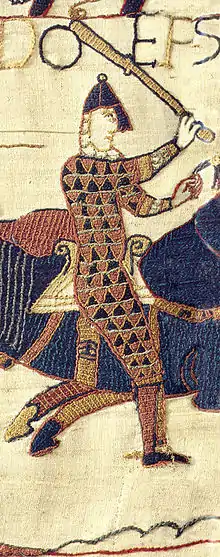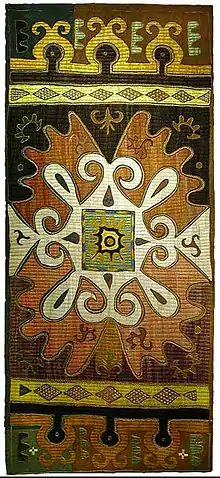Choli
A choli (Hindi: चोली, Gujarati: ચોળી, Marathi: चोळी, Nepali: चोलो cholo) (known in South India as ravike (Kannada: ರವಿಕೆ, Telugu: రవికె, Tamil: ரவிக்கை)) is a blouse or a bodice-like upper garment that is commonly cut short leaving the midriff bare, it is worn along with a sari in the Indian subcontinent. The choli is also part of the ghagra choli costume in the Indian subcontinent.

In Northern Gujarat bordering Rajasthan, Palanpur in particular (Banaskantha), Polku, Gujarati: પોલકું word was used.
Evolution

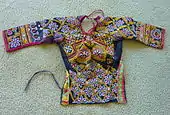


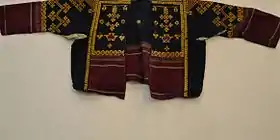
The choli evolved from the ancient stanapatta, also known as kurpsika or kanchuki, which was one of the forms of three-piece attire worn by women during the ancient period.[1] This consisted of the antriya lower garment; the uttariya veil worn over shoulder or head; and the stanapatta, a chestband, which is mentioned in Sanskrit literature and Buddhist Pali literature during the 6th century BC.[2]
Paintings from Maharashtra and Gujarat from the first millennium BCE are considered the first recorded examples of the choli.[3] Poetic references from works such as Silapadikkaram indicate that during the Sangam period (third-century BCE to fourth-century CE in ancient South India), a single piece of clothing served as both lower garment and upper shawl.[4] Paintings and sculpture indicate that the stanapatta evolved into the choli by the first century CE, in various regional styles.[5] Rajatarangini, a tenth-century literary work by Kalhana, states that the choli from the Deccan was introduced under the royal order in Kashmir.[6]
Early cholis were front-covering and tied at the back. Cholis of this kind are still common in state of Rajasthan.[7] In Nepal, the garment is known as a cholo, and in Southern India as a ravike. Both of these styles are tied at the front, unlike Northern Indian cholis, which are tied at the back. In parts of the Hindi Belt, mostly in Rajasthan, Haryana and Uttar Pradesh, women wore vest-like garments, known as kanchli, over choli; this complete costume is known as the poshak.[8]
Historical paintings
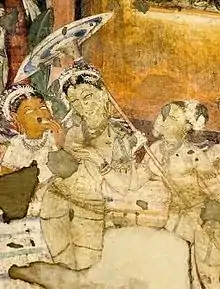 Women in Choli and Antariya CE 320 Gupta Empire.
Women in Choli and Antariya CE 320 Gupta Empire.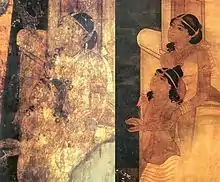 Women in Choli CE 320 Gupta Empire. The early form of Choli tied at the back with the front covering.
Women in Choli CE 320 Gupta Empire. The early form of Choli tied at the back with the front covering.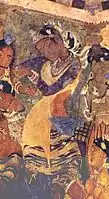 Dancing girl in Kurta/Salwar-like Choli Gupta Empire.
Dancing girl in Kurta/Salwar-like Choli Gupta Empire.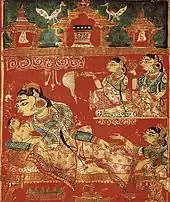 Kalpasutra Manuscript c. 1375–1400. Example of early form of full sleeve choli.
Kalpasutra Manuscript c. 1375–1400. Example of early form of full sleeve choli. Detail of Vasant Ragini, Rajastani painting 1500s showing early form of choli tied at the back.
Detail of Vasant Ragini, Rajastani painting 1500s showing early form of choli tied at the back. Bhagavata Purana manuscript c. 1525–40
Bhagavata Purana manuscript c. 1525–40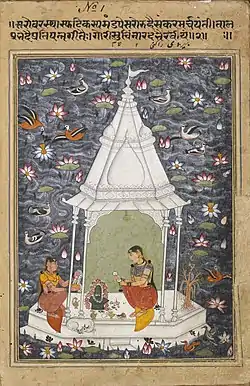 Bhairavi Ragini, Manley Ragamala manuscript c. 1610.
Bhairavi Ragini, Manley Ragamala manuscript c. 1610.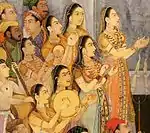 Female musicians at Aurangzeb's wedding - Mughal c. 1636.
Female musicians at Aurangzeb's wedding - Mughal c. 1636. Krishna flirting with the Gopis, to Radhas sorrow - Kangra Painting c. 1760. Full sleeve choli and bodies are worn in Himalayan states of India.
Krishna flirting with the Gopis, to Radhas sorrow - Kangra Painting c. 1760. Full sleeve choli and bodies are worn in Himalayan states of India.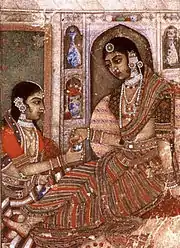 Lady being offered wine, Deccan, 1600 CE.
Lady being offered wine, Deccan, 1600 CE.
Historic photographs
 Woman in Gagra Choli
Woman in Gagra Choli Tamil girl in choli
Tamil girl in choli Tamil women in choli
Tamil women in choli Bengali girl in full sleeve choli (1880)
Bengali girl in full sleeve choli (1880) Sri Lankan woman in choli (1880)
Sri Lankan woman in choli (1880)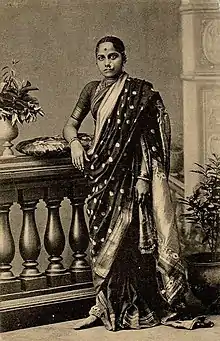 Marathi woman in choli
Marathi woman in choli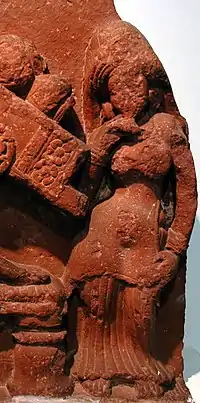 Plaque depicting ancient form of long choli and gagra worn during Gupta Empire
Plaque depicting ancient form of long choli and gagra worn during Gupta Empire Woman in Sindhi choli 1845
Woman in Sindhi choli 1845
Changing times
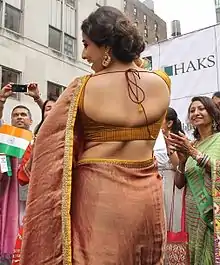

Traditionally, the choli has been made from the same fabric as the sari, with many sari producers adding extra length to their products so that women can cut off the excess fabric at the end of the sari and use it to sew a matching choli. For everyday wear, cotton-based materials and silk cotton are widely considered the most comfortable. Chiffon and silk are best suited for formal occasions.[11] The ideal fabric for cholis in the summer is chiffon and georgette.[12]
Designers have experimented with the choli, influencing pop-culture fashion in the Indian subcontinent, with adventurous tailoring and innovative necklines, such as halter, tubes, backless or stringed.[10] Anupama Raj, a designer and boutique owner, commented that "there is a very real need to re-invent the choli so that it can be worn with a variety of outfits. Just as we see the choli to be a deconstructed form of the blouse, we need to deconstruct the choli." Bobby Malik, an exporter-turned-designer commented "the choli is the most sensuous of all garments created for women. It not only flatters the feminine form, but also brings out the romanticism in a woman. But where Indian designers have failed is at giving it an international look and making it still more beautiful."[13]
Recent styles
See also
References
- Prachya Pratibha, 1978 "Prachya Pratibha, Volume 6", p. 121
- Agam Kala Prakashan, 1991 "Costume, coiffure, and ornaments in the temple sculpture of northern Andhra", p. 118
- Prachya Pratibha, 1978 "Prachya Pratibha, Volume 6", p. 121
- Linda Lynton, Sanjay K. Singh (2002) "The Sari: Styles, Patterns, History, Techniques.", p. 40
- Prachya Pratibha, 1978 "Prachya Pratibha, Volume 6", p. 121
- Katiyar, Vijai Singh (2009). Indian saris : traditions, perspectives, design. New Delhi: Wisdom Tree in association with National Institute of Design, Ahmedabad. p. 211. ISBN 9788183281225. Retrieved 31 October 2015.
- Chander, Prakash (2003). India: past & present – Prakash Chander. ISBN 9788176484558. Retrieved 13 November 2011 – via Google Books.
- Bhandari, Vandana (2005). Costume, textiles and jewellery of India: traditions in Rajasthan. Mercury Books. p. 84. ISBN 9780811810845.
- Nimisha Tiwari (19 June 2011). "The choli lowdown!". Times of India. Retrieved 19 July 2017.
- "Vidya Balan puts plunge cholis on fashion map". Times of India. December 20, 2011. Retrieved 12 April 2012.
- Sarkar, Neeti (June 26, 2010). "Choli ke peeche". The Hindu. Retrieved 21 March 2012.
- Singh, A. D. (March 10, 2012). "Summer breezers". Deccan Chronicle. Retrieved 21 March 2012.
- Roy, Sumona (August 31, 2002). "Deconstructing the choli into daring designs". The Tribune. Retrieved 13 April 2012.
External links
 Media related to Choli at Wikimedia Commons
Media related to Choli at Wikimedia Commons



.jpg.webp)



.jpg.webp)
.jpg.webp)
.jpg.webp)


